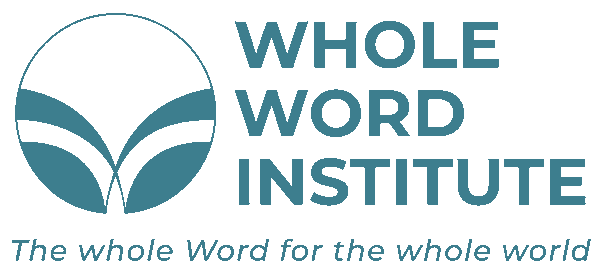
Modular Language Intensives

Field Internships

Internet Courses

Mentoring
CONNECT TO
THE SOURCE
Global Online Learning
Study with the Center for Extension Learning
Field-based training of translators & consultants globally
Hebrew Extension Learning Program (HELP)
A Multi-Certificate, Maximally Efficient, Hebrew Program for the Whole World
The Hebrew Extension Learning Program is a distance learning program that builds upon the proven foundation of biblical source language training that Whole Word Institute has successfully operated in Jerusalem to serve the specific goals of the Bible Translation movement, its agencies, translators and consultants.
OVERVIEW
Goal
To train translators and consultants globally in Hebrew, achieving a level where they are working within Hebrew to translate the Bible from the source language.
The HELP is a blended online course combining both synchronous and asynchronous instruction, utilizing the same pedagogical methodologies employed in Jerusalem. It covers the training content of the intensive program in Jerusalem, but the training is spread over a longer period so that it can accommodate translators’ and consultants’ ongoing responsibilities in the field. It is uniquely positioned to serve indigenous translators/consultants whether in a translation agency or CCBT context.
Stages & Requirements
As with the residential program the HELP MA equips translators and consultants to be able to translate directly from the Biblical Hebrew text into the receptor language, thus producing better translations done faster and cheaper.
The HELP is designed in three stages:
STAGE 1: “Certificate in Biblical Hebrew” (18 credits)
STAGE 2: “Certificate in Biblical Hebrew Culture and Geography” (14 credits)
STAGE 3: “Certificate in Advanced Hebrew” (24 credits)
Successful completion of each of the first two stages culminates in a graduate certificate. An accredited MA degree in Classical (Biblical) Hebrew is earned upon completion of the 3rd stage.
The training provided in the three certificates completes the course requirements for an MA in Classical Hebrew. Successful students will complete level three (level gimel) of modern Hebrew enabling them to independently read and study the Hebrew Bible and to use secondary tools, including those written in Hebrew. This represents a threshold professional skill level for translators and consultants to work from and within the source text of the Hebrew Bible. It is recommended that all translation consultants and at least one person on every translation project attain this threshold professional level of working from the source language.
The general framework of each of the courses within the 1st and 3rd certificates requires:
- 45-50 hours of asynchronous preparatory learning done individually online (1 credit). This is generally completed over a period of 8-12 weeks.
- The prerequisite work is followed by 30 hours of synchronous online “classroom” learning coupled with 60 hours of individual homework (2 credits). This is generally completed in an intensive 4-week format during which the participant is engaged half-time in language learning.
The second certificate is done on location in Israel in 3 months.
THE FIRST STAGE: 'CERTIFICATE IN BIBLICAL HEBREW'
The 18-credit program may be thought of as the equivalent of “three years of university or seminary Hebrew,” with the added advantage of being taught as CLT (Communicative Language Teaching) where the teaching enhances rapid internalization of the language. This sets a high introductory platform for training translators and consultants.
Certificate Outcomes:
-
Successful students will build a robust foundation towards achieving a level of independently working from the source text. (Such a skill level will be attained during the third certificate stage.)
-
Translation team members with this certificate would be able to meaningfully discuss source translation issues with other team members and consultants.
-
This first certificate provides a practical place for evaluation. Dependent upon course evaluation results, students may be recommended to proceed to further training, or they may be recommended to concentrate on other aspects of the translation task than source comprehension. Students who have successfully completed the certificate and recommended to continue would be ideal candidates for scholarships for the second certificate.
The 6 courses of the “Certificate in Biblical Hebrew” are:
COURSE 1: “ORAL FOUNDATIONS OF BIBLICAL HEBREW, JONAH A.” (3 CREDITS)
Learning objectives for Oral Foundations of Biblical Hebrew, Jonah A & B:
-
Remapping of cerebral neurons so as to integrate the language within the oral-aural networks of the brain
-
Discovery learning of the Hebrew alphabet
-
Acquisition of 300 vocabulary words
-
Reading and comprehension of the Jonah text
-
Laying a foundation for appreciating authorial choice in narrative syntax
In order to learn biblical Hebrew at a fast pace and to internalize it, a person must re-orient and re-map their cerebral neurons to process biblical Hebrew as a human language. This module provides a spoken biblical Hebrew environment and also an opportunity for those with a previous background in biblical Hebrew to re-lay the foundations of biblical Hebrew so that it is integrated within the oral-aural networks of the brain. Natural language processes will be sped up, as will reading skills. This module becomes the foundation for the further language development through the program.
“Oral Foundations of Biblical Hebrew A” is a beginning Hebrew language course based on the book of Jonah. 50 hours of asynchronous prerequisite preparation introduce over 200 vocabulary items within a discovery picture framework. The alphabet is also discovered and practiced in parallel lessons after or during the picture introductions. After the 50 hours of asynchronous prerequisite training, synchronous online sessions are run in Biblical Hebrew. The narrative of Jonah is read, with an emphasis on comprehension, authorial choices, combined with acting out dialogues, memorizing Bible passages, and participating in ‘live’ language. (Optional homework material provides glosses and explanations in English, also available in French.) Courses taught in Hebrew but need English to set up the internet interface.
* Persons with advanced analytical knowledge of biblical Hebrew have profited from this module and recommend it despite its “introductory” status.
COURSE 2: “ORAL FOUNDATIONS OF BIBLICAL HEBREW, JONAH B.” (3 CREDITS)
This course is a continuation of Course 1 and completes the book of Jonah. Students prepare 50 hours of asynchronous work before the synchronous sessions meet to complete the course.
COURSE 3: INTRO TO MODERN HEBREW WITH SELECTED READINGS IN HEBREW BIBLE–A, (3 CREDITS):
Learning objectives:
-
Learning vocabulary useful for daily life, which helps to initiate personal and practical “thinking in the language.”
-
Increasing fluency for common daily situations
-
Mastery of the first half of modern Hebrew level Aleph
-
Continued deepening and internalization of biblical Hebrew through reading and discussion of texts
Students will prepare 50 asynchronous hours of modern Hebrew before the synchronous course. This may be achieved by working through a course like Rosetta Stone, units 1-6, or equivalent. The course will work with daily modern vocabulary while simultaneously reading and discussing selected Biblical texts with students (e.g., Ruth).
COURSE 4: “HEBREW NARRATIVE: ABRAHAM” (3 CREDITS)
Learning objectives:
-
Understanding the syntax, morphology, and discourse structures of biblical Hebrew
-
Understanding of verb morphology, of both regular and weak verbs
-
Attainment of intermediate-level reading skills
-
Attainment of intermediate-level of language internalization and retention
This is an intermediate biblical Hebrew course based on a selection of biblical texts from Genesis, revolving around Abraham. An asynchronous pre-requisite training of 50 hours provides added preparation from between the Jonah course and this “Abraham” course. This course, both asynchronous and synchronous parts, integrates the syntax, morphology, and discourse structures of biblical Hebrew (text linguistics), while expanding comprehension through reading. The online synchronous sessions function in Hebrew, using an immersion approach, and includes TPRS (Teaching Proficiency through Reading and Storytelling). Verb morphology is reviewed, both regular and weak verbs. The spoken biblical Hebrew environment enhances long-term retention and facilitates future studies in more advanced biblical Hebrew or other dialects of Hebrew. Extra stories are told in biblical Hebrew in order to illustrate and to help internalize these features. As part of the homework, written explanations about Hebrew structures are provided in English and Hebrew. Recorded material for listening is also included in the homework in order to increase internalization.
COURSE 5: INTRODUCTION TO MODERN HEBREW WITH SELECTED READINGS IN HEBREW BIBLE–B, (3 CREDITS):
Learning objectives:
-
Learning additional vocabulary useful for daily modern life
-
Increasing fluency for common daily situations
-
Mastery of second half of modern Hebrew level Aleph
-
Continued deepening and internalization of biblical Hebrew through reading and discussion of texts
Students will prepare 50 asynchronous hours of modern Hebrew before the synchronous course. This may be achieved by working through additional material like Rosetta Stone, units 7-12, or equivalent. The course will work with daily modern vocabulary while simultaneously reading and discussing selected biblical texts with students (e.g., Genesis 1-11).
COURSE 6: ADVANCED-INTERMEDIATE HEBREW: NARRATIVE [SAMUEL] (3 CREDITS)
Learning objectives:
-
Understanding of literary choices made by the biblical authors
-
Attainment of advanced-intermediate level understanding of verb morphology and syntax patterns for Biblical Hebrew
This is an advanced-intermediate course based on selected narrative texts (First Samuel). The course includes a 50-hour asynchronous preparation that prepares for 28 synchronous hours plus individual homework. Beyond the continued reinforcement of verb morphology and syntax patterns for biblical Hebrew, there is a focus on understanding the literary choices made by the biblical author(s) and the literary function of the texts. This looks at the syntax and the structural and explicit choices that a biblical author makes in writing a text, applying principles of discourse grammar and text linguistics. The instruction is in Hebrew to enhance long-term retention and to facilitate future studies in either advanced biblical Hebrew or other dialects of Hebrew.
THE SECOND STAGE: 'CERTIFICATE IN BIBLICAL HEBREW CULTURE AND GEOGRAPHY'
This second certificate includes in-person training in both biblical Hebrew and modern Hebrew in order to enhance the overall language program. It is structured differently from the first certificate as it includes an intensive 12-week study tour in Jerusalem. The 14-credit certificate consists of 2 segments:
-
2 credits (80 hours) of predominantly asynchronous learning with synchronous support. (These 2 credits may be facilitated by studying with a group either in-person at a translation center, or online, and may be further supplemented by mentoring supervision.)
-
12 credits immersive onsite study in Jerusalem and the land of the Bible.
Certificate Outcomes:
-
Advancement toward minimal professional level of source language skill by attainment of Hebrew level “bet”
-
First-hand acquaintance with the Land of the Bible
-
Understanding of biblical Hebrew culture and its significance to translation
-
Ability to meaningfully discuss source language translation issues
The “Certificate in Biblical Hebrew Culture and Geography” enhances and builds on the first certificate. It effectively doubles the amount of Hebrew interaction over the first certificate for a significant advancement toward a minimal professional level of source language skill. In addition, it rewards the diligent student from the first certificate with first-hand acquaintance with the Land and with live, in-person language use. Students are expected to complete the second level of Hebrew fluency (level bet) during the Jerusalem program. Successful students will be close to a level where they can independently work from the source language. They will be recommended to complete a third collection of courses to reach such a level.
This second certificate also provides a practical place for evaluation. Students may be recommended to proceed to further training, or they may be recommended to concentrate on other aspects of the translation task than improved source comprehension. Translation team members with this certificate would be able to meaningfully discuss source translation issues with other team members and consultants. Recommended students who have successfully completed the second certificate would be ideal candidates for scholarships for the third certificate and/or MA.
Second Certificate Course Descriptions:
COURSE 7: BIBLICAL HEBREW TEXTS RELATED TO GEOGRAPHY AND CULTURE (PREREQUISITE TO ISRAEL, 2 CREDITS):
Learning objectives:
-
Improvement of reading and comprehension skills
-
Mastering of variety of biblical Hebrew texts
-
Providing textual background and preparation for field trips in Israel
Students will prepare 80-100 hours of biblical Hebrew texts that includes synchronous support. The texts will be reread later onsite in Israel and as preparation for coursework in Jerusalem.
COURSE 8, JERUSALEM: “HEBREW, SPOKEN AND WRITTEN” (7 CREDITS)
Learning objectives:
-
Ability to read and comprehend printed articles in intermediate modern Hebrew
-
Enhanced fluency in spoken Hebrew
-
Mastery of Hebrew level Bet
This course builds a foundation in Hebrew as a continuation of training started with the modern Hebrew pre-requisite. There is a focus on oral communication, in order to develop and enhance fluency. Students will be introduced to printed articles in easy Hebrew. Success in the course improves reading and understanding of biblical Hebrew. (Potentially taught in increments, e.g., 3+1+1+1+1)
COURSE 9, JERUSALEM: “TEXTS, LAND, AND CULTURE: FIELD TRIPS “ (3 CREDITS)
Learning objectives:
- Understanding of historical and geographical interactions influencing the biblical text and its translation
Various sites in Israel are visited and biblical texts and ancient inscriptions related to the sites are read and discussed in Hebrew. The cultural, historical, and geographical interactions with the biblical texts are emphasized. A description and overview is provided in biblical Hebrew, with a time for questions and answers on location (in Hebrew, and with optional English summaries).
COURSE 10, JERUSALEM: “TEXTS, LAND AND CULTURE: SOCIETY & CULTURE IN THE BIBLE” (2 CREDITS)
Learning objectives:
-
Understanding of cultural configurations in biblical times as relevant to translation
-
Mastery of biblical Hebrew key concepts
This course focuses on the cultural configurations of ancient life in Israel, the family, the agricultural cycle, cosmology, legal framework, and temple worship. It includes key concepts for Hebrew terms, relevant for Bible translators
THE THIRD STAGE: 'CERTIFICATE IN ADVANCED HEBREW AND MA IN BIBLICAL HEBREW'
(For those with a BA or BA Equivalent: MA in Classical Hebrew
The third stage certificate is 24 credits. It may be completed online, outside of Israel with the student back in the home region where they are studying and potentially working on translation projects.
Certificate Outcomes:
-
Successful completion of the three stages may earn an accredited “MA in Classical Hebrew”
-
Achievement of Hebrew level Gimel
-
Ability to read and understand commentaries written in Hebrew
-
Ability to work within and from the source language
-
Attainment of minimum fluency level for translating directly from the Hebrew Bible
The third stage of courses is intended to synthesize the training in biblical Hebrew and to bring the student up to a level three (level gimel) fluency where they can begin to effectively access some commentaries that are written in Hebrew. They will have achieved a level of working within and from the Hebrew Bible itself, a minimal fluency level for translating from the Hebrew Bible.
COURSE 11: HEBREW, SPOKEN AND WRITTEN: (11 CREDITS)
Learning objectives:
- Mastery of Hebrew level Gimel
This course continues to build vocabulary and fluency in Hebrew. Instruction includes reading and discussing printed articles and secondary literature on the Bible. Success in the course improves reading and understanding of biblical Hebrew.
(Potentially in mini-modules, e.g., 2+2+2+2+2+1)
COURSE 12: ADVANCED-INTERMEDIATE BIBLICAL HEBREW: POETRY AND PSALMS (2 CREDITS)
Learning objectives:
-
Understanding of poetic verbal structures
-
Understanding of literary styles and structures used by the biblical poets
-
Attainment of advanced-intermediate level understanding of poetic vocabulary
-
Understanding of cultural background influencing biblical poetry
This course focuses on Hebrew poetic literature in the Bible. There is a 50-hour asynchronous preparation followed by 28 hours of synchronous instruction plus homework. The verbal system within poetry is examined, along with an understanding of the literary styles and structures used by biblical poets. This course increases a student’s poetic vocabulary, and gives cultural background to better appreciate the poetic parts of the Hebrew Bible. Instruction is in Hebrew.
COURSE 13: ADVANCED-INTERMEDIATE BIBLICAL HEBREW: LEGAL TEXTS (2 CREDITS)
Learning objectives:
-
Understand a broader legal lexicon and syntax
-
Appreciate the forms of legal material and case law, and their development in society
This course focuses on selected legal texts in the Torah. Various strata of legal texts are viewed in their intra-biblical relationship as well as their social and historical roles in the history of Israel, opening up a canonical and cultural resource for Christian readers and Bible translators. Instruction is in Hebrew.
COURSE 14: ADVANCED BIBLICAL HEBREW: HISTORY OF THE HEBREW LANGUAGE (1 CREDIT)
Learning objectives:
-
Understanding of the development history of the Hebrew language
-
Ability to evaluate exegetical proposals in secondary literature from chronological and dialectical perspectives
This course includes representative readings that illustrate the features and strata of Ancient Hebrew, First-Temple Hebrew, Second-Temple Hebrew, and Mishnaic Hebrew. An understanding of the development of the Hebrew language is useful in guiding students in evaluating exegetical proposals in secondary literature. Instruction is in Hebrew.
COURSE 15: ADVANCED HEBREW SYNTHESIS (2 CREDITS)
Learning objectives:
-
Comprehensive integration of language details of Biblical Hebrew in morphology, syntax and literary and discourse structure.
COURSE 16: ADVANCED SEMINAR IN BIBLICAL HEBREW INTERPRETATION: SEMINAR (3 CREDITS)
Learning objectives:
- Integration of language skills and contextual background as applied to biblical interpretation
This course is designed to integrate the language skills and background accumulated in the program. Selected texts from Isaiah (or other texts, rotated yearly) will be studied. Students will engage exegetical issues and develop research skills through written projects. Instruction is in Hebrew though papers and assignments may be written in other, agreed-upon languages.
COURSE 17: HISTORY OF ISRAEL & ANCIENT NEAR EAST (1 CREDIT)
Learning objectives:
- Understanding of biblical history and the context of the Ancient Near East as it applies to translation issues
This course looks at the history of Israel from the biblical perspective and in relation to the Ancient Near East. Instruction is in Hebrew with readings either in English or Hebrew.
(May be fulfilled as a directed reading.)
COURSE 18: מבוא למקרא INTRODUCTION TO THE HEBREW BIBLE, INCLUDING MASORETIC TEXT (2 CREDITS)
Learning objectives:
- Understanding the Hebrew Bible as a literary and canonical text
This course introduces the Hebrew Bible as a literary and canonical text. Issues related to original purposes, audiences, genre, compositional history and historical reception are discussed. Also included are the development and status of the Masoretic text and the relationship and impact of the Hebrew Bible to the New Testament. Instruction is in Hebrew. (May be fulfilled as a directed reading.)
Tailored Completion Timelines:
The time projection for the completion of these stages will depend on individual situations. The program is designed so that persons may receive other translation training and may participate in other translation projects during the course of this Hebrew training.
Variable sample timelines for completion of the program:
The first certificate would take approximately 2 years to complete if three modules were completed each year. That would entail an average workload of 1 hour of Hebrew study for every day.
The second certificate would probably take place in a shorter time because of the intensive 12-week session in Jerusalem. However, the preparation for Jerusalem would entail 80 study hours, which is approximately 6.5 hours per week if spread over 12 weeks. That is “quarter time” for one quarter of a year, plus a three-month time in Jerusalem. The second certificate could be expected to be done in a half-year or less should the asynchronous work be concentrated into a shorter time frame.
Finally, the third certificate and culmination of the MA degree requires an additional 24 credits or about 960 hours of total work. At one hour per day, that is three years of work, and at two hours per day that is 18 months, and so forth. The total time for completion is dependent upon the amount and rate of time committed to completion of the program.
This program could be viewed as a part-time MA program spread out over 3-5 years. It compares with the fully accredited 1-year MA in Classical (Biblical) Hebrew program offered in Jerusalem. The online framework of the program allows many students to begin the program who would otherwise be excluded. The “cost” for such inclusion and flexibility is a longer overall time frame. Diligent students and programs that organize and monitor the ongoing work will be rewarded with unprecedented training and a chance to train in Israel. Students will be expected to be working and engaged with Bible translation agencies during this period.
QUICK FACTS
WHEN: Next program begins in 2024
WHERE: Online cohorts will be formed by 3 timezone regions: Region 1: Asia Pacific; Region 2: Europe, Middle East, and Africa; Region 3: Americas
*The second certificate includes an intensive 12-week study tour in the Land of the Bible and in-person training in both biblical Hebrew and modern Hebrew in order to enhance the overall language program.
Application Deadline: March 31, 2024
Please contact us for more information.
TUITION & FEES
- Tuition for each certificate is $4,200 (USD)
- Room & Board in Jerusalem (3 months of the 2nd certificate) an additional $4,200
SCHOLARSHIPS
- Scholarships may be available to qualifying individuals upon request, with priority given to those working with translation agencies.
- Please fill in the scholarship eligibility questionnaire on the application form.
For questions write to: [email protected]
